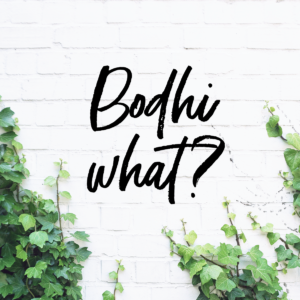To get that awkward moment of saying something we don’t know how to pronounce out of the way, let’s start with pronunciation: bodhicitta bow dee chi tah and bodhisattva bow dee saat va. To keep them separate, think bodhicitta is a mind and bodhisattva is a person with that mind. I like to think that bodhisattva contains the word “sat” and only a person can do that, not a mind. That’s one way to keep them straight. Of course, there’s a lot more to it than that, as we’ll explain.
What is bodhicitta?
There are two kinds of bodhicitta: conventional and ultimate. Conventional bodhicitta is a mind that wishes to free beings from suffering and bring them to the state of enlightenment. The second definition of bodhicitta is ultimate bodhicitta, which is a mind that has realized emptiness.
What is a bodhisattva?
A bodhisattva is a person who has that bodhicitta mind. There are two ways that are often talked about when defining a bodhisattva. The first is that by merely generating the attitude of bodhicitta, that wish to free beings from suffering and bring them to enlightenment, one gets the title of bodhisattva. The second is that you are considered a bodhisattva once you have a direct realization of the truth of emptiness. A person can be defined as a bodhisattva in different contexts depending on whether they have generated the attitude of conventional bodhicitta or have that realization of emptiness of ultimate bodhicitta. Even though in the Way of the Bodhisattva, Shantideva says that one attains the name “bodhisattva” the instant they develop the mind of bodhicitta, when the word “bodhisattva” is used in Buddhist texts, it almost exclusively refers to one who has directly realized emptiness.
What’s the meaning of bodhicitta and bodhisattva in Sanskrit?
In Sanskrit, bodhicitta is the mind of enlightenment, and bodhisattva means enlightenment-being or enlightenment person: someone who is engaged in the path to enlightenment.
What’s the meaning of bodhicitta and bodhisattva in Tibetan?
Before we dive into this short Tibetan lesson, we would like to thank Justin Kirkwood, one of Namchak’s Tibetan translators, for sharing his Tibetan knowledge with us!
There are key differences between the Sanskrit and Tibetans forms of these words. The words for bodhisattva in Tibetan are jang chup sem pa. Jang chup means enlightenment. Sem pa means the person who gets involved with enlightenment. They may seem short, but when translated the syllables Jang and chup provide an in-depth description of enlightenment.
Jang means totally purified. When you’re working towards becoming a Buddha, what you’re doing is trying to eliminate all of the things that obscure you – your afflictive mental and emotional states and your ignorance. This aspect of purifying all the things obscuring true reality is considered one aspect of enlightenment. Chup means to have fully realized everything. Therefore, jang chup means that you have eliminated everything that was obscuring reality and that you have fully assimilated or realized the nature of everything.
Then we come to sem pa. Sem means mind. Therefore, jang chup gi sem means bodhichitta, the mind of enlightenment. The syllable pa means someone who is courageous. Sanskrit doesn’t have the connotation of pa, someone who’s brave. This is a Tibetan word, and it refers to the courage and mental fortitude needed to take on the commitment to free all living and infinite beings from suffering and into Buddhahood. It’s a commitment that requires a lot of courage. That’s why they’re called the courageous people focused on enlightenment.
How can one create a more enlightened mind?
Enlightenment is defined as a state in which all of one’s ignorance, mental and emotional afflictions, and habitual patterns have been completely purified and they have fully realized the nature of reality. The way we bring ourselves closer to that state is through the practice of Shamata and Vipassana mediation. We calm our minds through Shamata, so that it’s clear and stable. Once that’s accomplished, we can familiarize ourselves with reality through Vipassana meditation, which is that investigation into emptiness and selflessness. In that process, we are purifying our afflictive emotions, gaining the power of realization, and becoming more enlightened.
Are there any bodhicitta meditations or mantra practices?
Bodhicitta mind has two aspects, conventional and ultimate. Within conventional bodhicitta, the training is two-fold as conventional bodhicitta itself has two aspects: aspirational and engaged bodhicitta. First, we develop the mindset, then we engage in it.
In order to develop aspirational bodhicitta, we first cultivate the wish to liberate beings from suffering and bring them to enlightenment. That’s why it’s called aspirational bodhicitta. It’s not necessarily engaging in any action towards the wish but developing the wish itself. The second side of that is engaged bodhicitta. To break it down: If we want to go to a place, that’s our aspiration; and by taking the steps to get there, that’s our engagement.
For the beginner, we recommend starting with development of aspirational bodhicitta. The practices for developing this are the meditations and contemplations of the Four Boundless Thoughts, Tonglen, equalizing and exchanging yourself and others, and cherishing others more than yourself. Once we develop and stabilize that attitude of aspirational bodhicitta, we then step towards engaged bodhicitta.
The way to practice engaged bodhicitta is through the practices of the Six Perfections. The Six Perfections are generosity, discipline, patience, diligence, concentration (or meditation), and wisdom.
The main way to train for ultimate bodhicitta is practicing Vipassana meditations on selflessness and emptiness. Keep an eye on our events page for upcoming Vipassana retreats with Namchak Khen Rinpoche.
If you want to read more about this subject, we recommend The Way of the Bodhisattva by Shantideva, and The Nectar of Manjushri’s Speech: A Detailed Commentary on Shantideva’s Way of the Bodhisattva by Kunzang Pelden.

Begin or rejuvenate your practice with one of our free Ecourses today!
